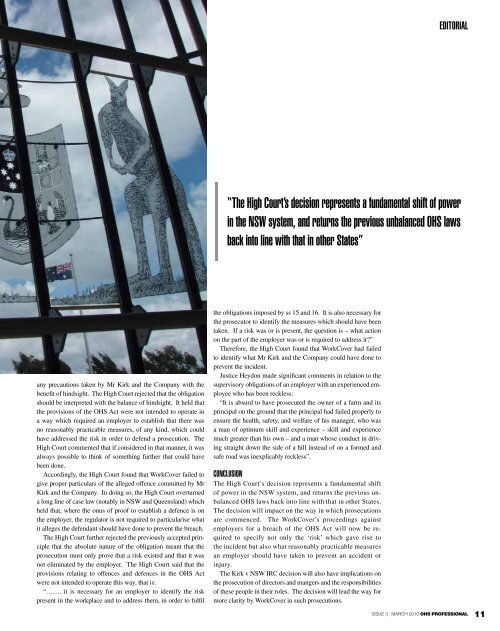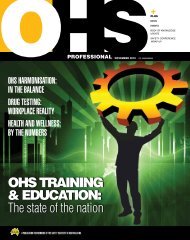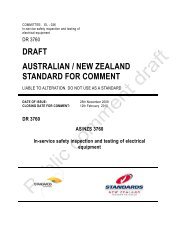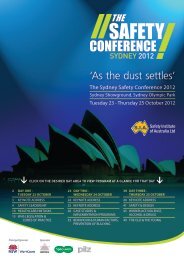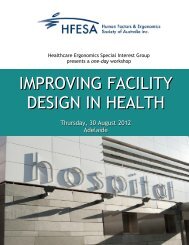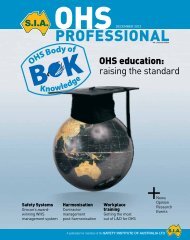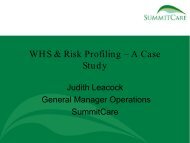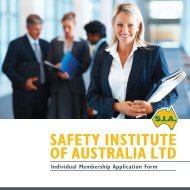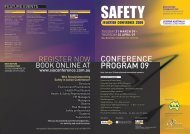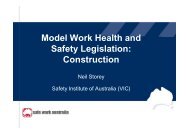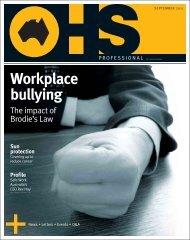Defence: overcoming its âcan Doâ culture unsW kills safety anD risk ...
Defence: overcoming its âcan Doâ culture unsW kills safety anD risk ...
Defence: overcoming its âcan Doâ culture unsW kills safety anD risk ...
You also want an ePaper? Increase the reach of your titles
YUMPU automatically turns print PDFs into web optimized ePapers that Google loves.
eDitorial“the high court’s decision represents a fundamental shift of powerin the nsW system, and returns the previous unbalanced ohs lawsback into line with that in other states”any precautions taken by Mr Kirk and the Company with thebenefit of hindsight. The High Court rejected that the obligationshould be interpreted with the balance of hindsight. It held thatthe provisions of the OHS Act were not intended to operate ina way which required an employer to establish that there wasno reasonably practicable measures, of any kind, which couldhave addressed the <strong>risk</strong> in order to defend a prosecution. TheHigh Court commented that if considered in that manner, it wasalways possible to think of something further that could havebeen done.Accordingly, the High Court found that WorkCover failed togive proper particulars of the alleged offence committed by MrKirk and the Company. In doing so, the High Court overturneda long line of case law (notably in NSW and Queensland) whichheld that, where the onus of proof to establish a defence is onthe employer, the regulator is not required to particularise whatit alleges the defendant should have done to prevent the breach.The High Court further rejected the previously accepted principlethat the absolute nature of the obligation meant that theprosecution must only prove that a <strong>risk</strong> existed and that it wasnot eliminated by the employer. The High Court said that theprovisions relating to offences and defences in the OHS Actwere not intended to operate this way, that is:“……. it is necessary for an employer to identify the <strong>risk</strong>present in the workplace and to address them, in order to fulfilthe obligations imposed by ss 15 and 16. It is also necessary forthe prosecutor to identify the measures which should have beentaken. If a <strong>risk</strong> was or is present, the question is – what actionon the part of the employer was or is required to address it?”Therefore, the High Court found that WorkCover had failedto identify what Mr Kirk and the Company could have done toprevent the incident.Justice Heydon made significant comments in relation to thesupervisory obligations of an employer with an experienced employeewho has been reckless:“It is absurd to have prosecuted the owner of a farm and <strong>its</strong>principal on the ground that the principal had failed properly toensure the health, <strong>safety</strong>, and welfare of his manager, who wasa man of optimum skill and experience – skill and experiencemuch greater than his own – and a man whose conduct in drivingstraight down the side of a hill instead of on a formed andsafe road was inexplicably reckless”.conclusionThe High Court’s decision represents a fundamental shiftof power in the NSW system, and returns the previous unbalancedOHS laws back into line with that in other States.The decision will impact on the way in which prosecutionsare commenced. The WorkCover’s proceedings againstemployers for a breach of the OHS Act will now be requiredto specify not only the ‘<strong>risk</strong>’ which gave rise tothe incident but also what reasonably practicable measuresan employer should have taken to prevent an accident orinjury.The Kirk v NSW IRC decision will also have implications onthe prosecution of directors and mangers and the responsibilitiesof these people in their roles. The decision will lead the way formore clarity by WorkCover in such prosecutions.ISSUE 3 | MARCH 2010 OHS PrOfeSSiOnaL 11


